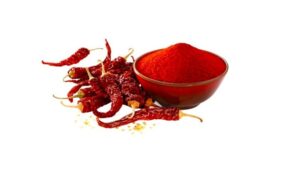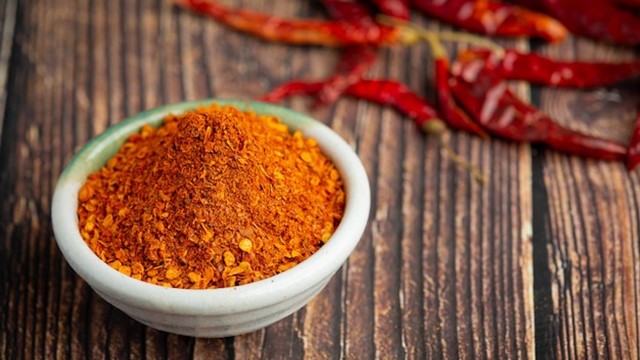Chili powder is a spice blend made by grinding dried chili peppers along with other complementary spices or herbs. It’s important to note that the term “chili powder” can vary in meaning based on regional differences. However, in many places, especially in the United States, chili powder typically refers to a blend made primarily from ground chili peppers along with other ingredients.

The key components in a standard chili powder blend often include:
Dried Chili Peppers:
These are the primary ingredient and can vary in type, such as ancho, chipotle, cayenne, New Mexico, or other dried red chili peppers. Each variety contributes its unique flavor profile and level of heat to the blend.
Additional Spices or Herbs:
Other common ingredients often found in chili powder blends may include cumin, garlic powder, onion powder, paprika, oregano, and sometimes salt or other spices. These additional ingredients contribute to the overall flavor complexity and depth of the chili powder.
Chili powder varies in heat level, depending on the type and quantity of chili peppers used. Some blends are mild, while others can be quite hot, imparting a range of flavors from smoky and earthy to fruity and fiery.
This spice blend is widely used in a variety of cuisines, particularly in Mexican, Tex-Mex, and Southwestern dishes. It adds depth, heat, and complexity to recipes like chili con carne, tacos, enchiladas, salsas, soups, stews, marinades, and spice rubs for meats. Its versatility makes it a popular and essential ingredient in many kitchens worldwide.
Varieties of Chili Powder
Chili powder comes in various varieties, each offering its unique flavor profile, heat level, and culinary applications. Here are some of the common varieties:
Ancho Chili Powder:
- Made from dried poblano peppers, ancho chili powder has a mild heat level and a sweet, smoky flavor. It’s widely used in Mexican cuisine, especially in sauces, moles, and meat rubs.
Chipotle Chili Powder:
- Prepared from smoke-dried jalapeño peppers, chipotle chili powder delivers a moderate to hot smoky flavor. It’s often used in barbecues, marinades, and dishes where a smoky kick is desired.
Cayenne Chili Powder:
- Created from ground cayenne peppers, this chili powder packs a significant punch of heat. It’s commonly found in spice blends, sauces, and as a seasoning for soups and chilis.
New Mexico Chili Powder:
- Made from dried New Mexico red peppers, this variety has a mild to medium heat level and offers earthy and fruity notes. It’s a key ingredient in New Mexican cuisine, used in enchiladas, salsas, and Southwestern dishes.
Kashmiri Chili Powder:
- Originating from Kashmiri red chili peppers, this powder has a vibrant red color and a moderate heat level with fruity undertones. It’s commonly used in Indian cuisine to add color and flavor to dishes like tandoori chicken and curry masalas.
Aleppo Chili Powder:
- Hailing from the Aleppo region in Syria, this variety is moderately spicy with a mild, fruity flavor. It’s used in Middle Eastern and Mediterranean cuisines, providing a balanced heat in various dishes.
Pasilla Chili Powder:
- Made from dried pasilla peppers, it has a mild to medium heat level and offers rich, earthy flavors with hints of berry and cocoa. It’s often used in sauces, salsas, and Mexican cuisine.
Thai Chili Powder:
- Derived from Thai bird’s eye chili peppers, this powder is extremely spicy and used in Thai cuisine to add heat and flavor to dishes like curries, soups, and stir-fries.
These varieties of chili powder differ in their heat levels, flavors, and the types of dishes they complement. Their distinct characteristics make them versatile ingredients that cater to diverse culinary preferences, allowing chefs and home cooks to add layers of depth and heat to their recipes based on their desired flavor profiles.
Culinary Uses and Versatility
Chili powder is a versatile spice blend that adds not just heat but also depth and complexity to a wide range of dishes. Here are the culinary uses and the versatility of chili powder:
Culinary Uses of Chili Powder
- Flavor Enhancement:
- Heat and Depth: Adds heat and depth of flavor to dishes without overpowering other spices or ingredients.
- Seasoning and Spice Blends:
- Essential Component: Integral in creating spice blends like taco seasoning, chili con carne mix, and curry powders, providing a distinct flavor foundation.
- Mexican and Tex-Mex Cuisine:
- Key Ingredient: Used in Mexican dishes such as enchiladas, tacos, burritos, and salsas, contributing to the characteristic flavors of these cuisines.
- Sauces and Marinades:
- Spicy Kick: Adds a spicy kick to sauces, barbecue marinades, and rubs for meats, enhancing their flavors.
- Soups and Stews:
- Heat and Depth: Used in soups, stews, and chilis to elevate their taste profile and provide warmth.
- Vegetarian and Vegan Dishes:
- Flavor Boost: Adds depth and richness to vegetarian or vegan dishes, including bean-based recipes, tofu dishes, and vegetable stir-fries.
- Baking and Snacks:
- Spicy Twist: Incorporated into baked goods like cornbread, spice cookies, or used to season popcorn, nuts, or roasted chickpeas for a spicy snack.
- Eggs and Dips:
- Flavorful Additions: Sprinkled over scrambled eggs or incorporated into dips like guacamole and hummus for an added kick.
- Meat Seasoning:
- Rub and Marinade: Used in spice rubs and marinades for meats, enhancing their flavor before grilling, roasting, or cooking.
- Cultural Fusion:
- Global Influence: Incorporating chili powder in diverse global cuisines, from Indian curries to Thai stir-fries, for an infusion of heat and flavor.
- Custom Blends:
- Personalized Seasoning: Combined with other spices to create custom blends tailored to specific recipes or individual preferences.
- Condiments and Dressings:
- Spicy Additions: Used in condiments, salad dressings, or as a finishing touch to add a zingy heat to various dishes.
Versatility in Heat and Flavor
- Heat Levels: Available in various heat levels, from mild to extremely hot, allowing for customization based on taste preferences.
- Flavor Profiles: Different varieties offer diverse flavor profiles, ranging from smoky and earthy to fruity and intense, contributing to a dish’s overall taste complexity.
Chili powder’s versatility lies in its ability to complement a wide array of dishes, from enhancing the flavors of traditional cuisines to adding a spicy twist to contemporary creations. Its heat and depth make it a fundamental spice in kitchens worldwide, offering a spectrum of flavors and culinary possibilities for chefs and home cooks alike.
Health Benefits of Chili Powder
Chili powder, derived from ground chili peppers and various spices, offers not only fiery flavor but also potential health benefits due to its nutritional content and the properties of its key ingredient, chili peppers. Here are some of the health benefits associated with chili powder:
Health Benefits of Chili Powder:
- Weight Management and Metabolism Boost:
- Capsaicin Content: Chili peppers, a primary component of chili powder, contain capsaicin, a compound known to potentially increase metabolism and aid in weight management by promoting fat burning.
Potential Pain Relief:
- Capsaicin Analgesic Effects: Topical applications of capsaicin derived from chili peppers have been linked to pain relief and reduced discomfort, especially in conditions like arthritis and neuropathic pain.
Cardiovascular Health:
- Heart Health: Capsaicin may help in promoting heart health by reducing cholesterol levels, improving blood circulation, and potentially lowering the risk of cardiovascular diseases.
Antioxidant Properties:
- Rich in Antioxidants: Chili peppers contain antioxidants like vitamin C and carotenoids, which combat free radicals and oxidative stress, potentially reducing the risk of chronic diseases.
Nutritional Content:
- Vitamins and Minerals: Chili powder, especially if it includes other spices, may contain vitamins A, C, and E, as well as minerals like potassium and magnesium, contributing to overall health.
Anti-inflammatory Effects:
- Reduced Inflammation: Some research suggests that capsaicin might possess anti-inflammatory properties, potentially aiding in reducing inflammation-related conditions.
Potential Pain Reduction:
- Endorphin Release: Eating spicy foods, including those seasoned with chili powder, can trigger the release of endorphins, providing a temporary sensation of pain relief and improved mood.
Gut Health:
- Digestive Benefits: Capsaicin may stimulate the production of digestive enzymes, potentially aiding digestion and relieving certain gastrointestinal issues.
Metabolic Effects:
- Improved Insulin Sensitivity: Some studies suggest that capsaicin may enhance insulin sensitivity, potentially aiding in better blood sugar regulation.
Appetite Suppression:
- Appetite Control: Spicy foods seasoned with chili powder might contribute to appetite suppression, potentially leading to reduced calorie intake.
It’s important to note that the potential health benefits of chili powder are often attributed to the chili peppers it contains, especially due to capsaicin—a compound known for its various health-supporting properties. However, individual responses to spicy foods may vary, and consuming chili powder excessively or if one has specific health conditions might cause discomfort or irritation.
Incorporating moderate amounts of chili powder into a balanced diet may offer various health advantages, but it’s advisable to consult with a healthcare professional, especially if you have any specific health concerns or conditions before significantly increasing its consumption.
Incorporating Chili Powder into Your Culinary Repertoire
Absolutely! Incorporating chili powder into your culinary repertoire can bring a delightful kick and depth of flavor to a wide range of dishes. Here’s a guide on how to use chili powder in your cooking:
Spice Blends and Seasonings:
- Taco Seasoning: Create your homemade taco seasoning by mixing chili powder with cumin, paprika, garlic powder, onion powder, oregano, and a pinch of cayenne for added heat.
- Chili Con Carne Mix: Use chili powder as a base for a robust chili con carne blend, incorporating other spices like cumin, coriander, and paprika.
Mexican and Tex-Mex Cuisine:
- Enchilada Sauce: Add chili powder to your enchilada sauce for an authentic Mexican flavor.
- Tacos and Burritos: Sprinkle chili powder on meats, beans, or vegetables for tacos, burritos, or fajitas.
Sauces and Dips:
- Salsas: Enhance your homemade salsa with chili powder for a spicy kick.
- Guacamole: Incorporate a pinch of chili powder into guacamole for added depth and heat.
Meat and Vegetable Seasoning:
- Marinades: Use chili powder in marinades for chicken, beef, or tofu before grilling or roasting.
- Vegetables: Toss vegetables in olive oil and chili powder before roasting or grilling for a spicy side dish.
Soups, Stews, and Beans:
- Chili and Soups: Add chili powder to chili con carne, bean soups, or lentil dishes for a warming flavor.
- Curries: Use chili powder as part of the spice blend for Indian-style curries for a hint of heat.
Baked Goods and Snacks:
- Spiced Snacks: Sprinkle chili powder on popcorn, nuts, or roasted chickpeas for a spicy snack.
- Spicy Cornbread: Add a touch of chili powder to cornbread batter for a unique twist.
Eggs and Breakfast:
- Scrambled Eggs: Add chili powder to scrambled eggs or omelets for an extra kick.
- Breakfast Burritos: Spice up breakfast burritos with a sprinkle of chili powder in the filling.
Global Fusion:
- Thai Cuisine: Use chili powder in Thai curries, stir-fries, or noodle dishes for a spicy Thai flavor profile.
- Indian Fusion: Incorporate chili powder into fusion dishes like spicy tacos or seasoned rice bowls for an adventurous blend of flavors.
Moderation and Taste Testing:
- Start Small: Use chili powder sparingly at first, tasting as you go to adjust the heat levels according to your preference.
- Balance Flavors: Combine chili powder with other spices to balance the heat and create a harmonious flavor profile in your dishes.
Chili powder’s versatility allows you to experiment and infuse dishes with various levels of heat and depth. Whether you’re cooking Mexican-inspired meals, adding a kick to your sauces, or spicing up everyday dishes, chili powder is a fantastic addition to your culinary repertoire. Adjust quantities based on your heat tolerance and enjoy the vibrant flavors it brings to your cooking!




